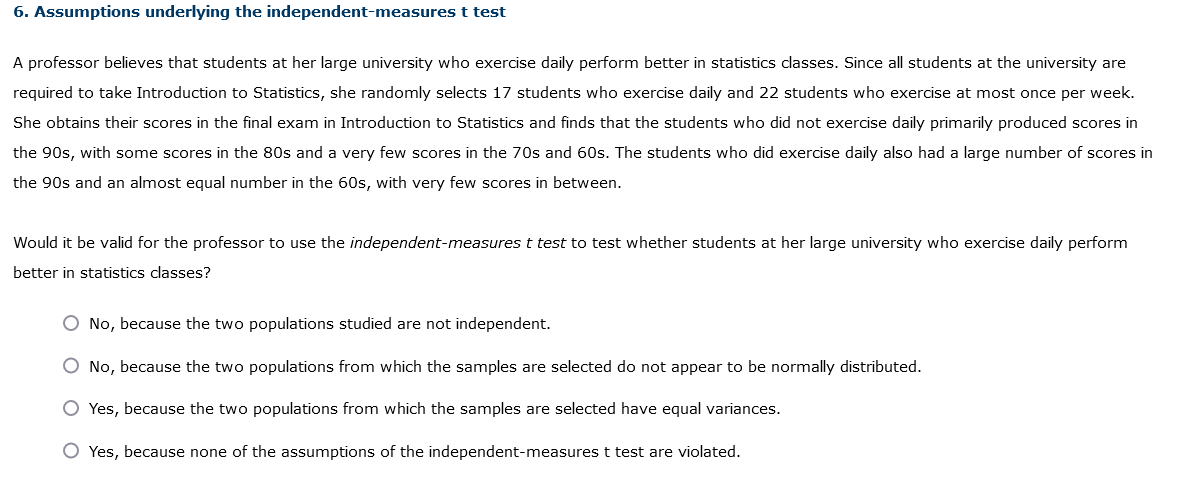A professor believes that students at her large university who exercise daily perform better in statistics classes. Since all students at the university are required to take Introduction to Statistics, she randomly selects 17 students who exercise daily and 22 students who exercise at most once per week. She obtains their scores in the final exam in Introduction to Statistics and finds that the students who did not exercise daily primarily produced scores in the 90s, with some scores in the 80s and a very few scores in the 70s and 60s. The students who did exercise daily also had a large number of scores in the 90s and an almost equal number in the 60s, with very few scores in between. Would it be valid for the professor to use the independent-measures t test to test whether students at her large university who exercise daily perform better in statistics classes? O No, because the two populations studied are not independent. O No, because the two populations from which the samples are selected do not appear to be normally distributed. O Yes, because the two populations from which the samples are selected have equal variances. O Yes, because none of the assumptions of the independent-measures t test are violated.
A professor believes that students at her large university who exercise daily perform better in statistics classes. Since all students at the university are required to take Introduction to Statistics, she randomly selects 17 students who exercise daily and 22 students who exercise at most once per week. She obtains their scores in the final exam in Introduction to Statistics and finds that the students who did not exercise daily primarily produced scores in the 90s, with some scores in the 80s and a very few scores in the 70s and 60s. The students who did exercise daily also had a large number of scores in the 90s and an almost equal number in the 60s, with very few scores in between. Would it be valid for the professor to use the independent-measures t test to test whether students at her large university who exercise daily perform better in statistics classes? O No, because the two populations studied are not independent. O No, because the two populations from which the samples are selected do not appear to be normally distributed. O Yes, because the two populations from which the samples are selected have equal variances. O Yes, because none of the assumptions of the independent-measures t test are violated.
Holt Mcdougal Larson Pre-algebra: Student Edition 2012
1st Edition
ISBN:9780547587776
Author:HOLT MCDOUGAL
Publisher:HOLT MCDOUGAL
Chapter11: Data Analysis And Probability
Section: Chapter Questions
Problem 8CR
Related questions
Question
Take your time answer the questions, this is all one question, please answer correctly, thank you very much, will write an wonderful review when solutions are done.

Transcribed Image Text:6. Assumptions underlying the independent-measures t test
A professor believes that students at her large university who exercise daily perform better in statistics classes. Since all students at the university are
required to take Introduction to Statistics, she randomly selects 17 students who exercise daily and 22 students who exercise at most once per week.
She obtains their scores in the final exam in Introduction to Statistics and finds that the students who did not exercise daily primarily produced scores in
the 90s, with some scores in the 80s and a very few scores in the 70s and 60s. The students who did exercise daily also had a large number of scores in
the 90s and an almost equal number in the 60s, with very few scores in between.
Would it be valid for the professor to use the independent-measures t test to test whether students at her large university who exercise daily perform
better in statistics classes?
O No, because the two populations studied are not independent.
O No, because the two populations from which the samples are selected do not appear to be normally distributed.
O Yes, because the two populations from which the samples are selected have equal variances.
O Yes, because none of the assumptions of the independent-measures t test are violated.
Expert Solution
This question has been solved!
Explore an expertly crafted, step-by-step solution for a thorough understanding of key concepts.
This is a popular solution!
Trending now
This is a popular solution!
Step by step
Solved in 4 steps

Recommended textbooks for you

Holt Mcdougal Larson Pre-algebra: Student Edition…
Algebra
ISBN:
9780547587776
Author:
HOLT MCDOUGAL
Publisher:
HOLT MCDOUGAL

Algebra & Trigonometry with Analytic Geometry
Algebra
ISBN:
9781133382119
Author:
Swokowski
Publisher:
Cengage

Holt Mcdougal Larson Pre-algebra: Student Edition…
Algebra
ISBN:
9780547587776
Author:
HOLT MCDOUGAL
Publisher:
HOLT MCDOUGAL

Algebra & Trigonometry with Analytic Geometry
Algebra
ISBN:
9781133382119
Author:
Swokowski
Publisher:
Cengage